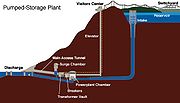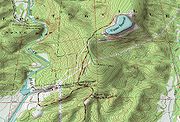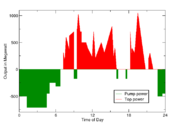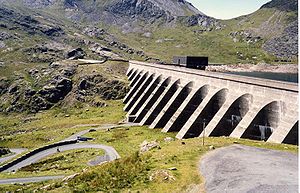
Pumped-storage hydroelectricity
Encyclopedia


Load balancing (electrical power)
Load balancing refers to the use of various techniques by electrical power stations to store excess electrical power during low demand periods for release as demand rises....
. The method stores energy in the form of water, pumped from a lower elevation reservoir to a higher elevation. Low-cost off-peak electric power is used to run the pumps. During periods of high electrical demand, the stored water is released through turbine
Turbine
A turbine is a rotary engine that extracts energy from a fluid flow and converts it into useful work.The simplest turbines have one moving part, a rotor assembly, which is a shaft or drum with blades attached. Moving fluid acts on the blades, or the blades react to the flow, so that they move and...
s to produce electric power. Although the losses of the pumping process makes the plant a net consumer of energy overall, the system increases revenue
Revenue
In business, revenue is income that a company receives from its normal business activities, usually from the sale of goods and services to customers. In many countries, such as the United Kingdom, revenue is referred to as turnover....
by selling more electricity during periods of peak demand
Peak demand
Peak demand is used to refer to a historically high point in the sales record of a particular product. In terms of energy use, peak demand describes a period of strong consumer demand.- Peak load :...
, when electricity prices are highest. Pumped storage is the largest-capacity form of grid energy storage
Grid energy storage
Grid energy storage refers to the methods used to store electricity on a large scale within an electrical power grid. Electrical energy is stored during times when production exceeds consumption and the stores are used at times when consumption exceeds production...
now available.
Overview

Francis turbine
The Francis turbine is a type of water turbine that was developed by James B. Francis in Lowell, Massachusetts. It is an inward-flow reaction turbine that combines radial and axial flow concepts....
design). Nearly all facilities use the height difference between two natural bodies of water or artificial reservoirs. Pure pumped-storage plants just shift the water between reservoirs, while the "pump-back" approach is a combination of pumped storage and conventional hydroelectric plants
Hydroelectricity
Hydroelectricity is the term referring to electricity generated by hydropower; the production of electrical power through the use of the gravitational force of falling or flowing water. It is the most widely used form of renewable energy...
that use natural stream-flow. Plants that do not use pumped-storage are referred to as conventional hydroelectric plants; conventional hydroelectric plants that have significant storage capacity may be able to play a similar role in the electrical grid
Electric power transmission
Electric-power transmission is the bulk transfer of electrical energy, from generating power plants to Electrical substations located near demand centers...
as pumped storage, by deferring output until needed.
Taking into account evaporation losses from the exposed water surface and conversion losses, approximately 70% to 85% of the electrical energy used to pump the water into the elevated reservoir can be regained. The technique is currently the most cost-effective means of storing large amounts of electrical energy on an operating basis, but capital costs and the presence of appropriate geography are critical decision factors.
The relatively low energy density of pumped storage systems requires either a very large body of water or a large variation in height. For example, 1000 kilogram
Kilogram
The kilogram or kilogramme , also known as the kilo, is the base unit of mass in the International System of Units and is defined as being equal to the mass of the International Prototype Kilogram , which is almost exactly equal to the mass of one liter of water...
s of water (1 cubic meter) at the top of a 100 meter tower has a potential energy of about 0.272 kW·h
Watt-hour
The kilowatt hour, or kilowatt-hour, is a unit of energy equal to 1000 watt hours or 3.6 megajoules.For constant power, energy in watt hours is the product of power in watts and time in hours...
(capable of raising the temperature of the same amount of water by only 0.23 Celsius = 0.42 Fahrenheit). The only way to store a significant amount of energy is by having a large body of water located on a hill relatively near, but as high as possible above, a second body of water. In some places this occurs naturally, in others one or both bodies of water have been man-made. Projects in which both reservoirs are artificial and in which no natural waterways are involved are commonly referred to as "closed loop".
This system may be economical because it flattens out load variations on the power grid, permitting thermal power stations such as coal-fired plants
Fossil fuel power plant
A fossil-fuel power station is a power station that burns fossil fuels such as coal, natural gas or petroleum to produce electricity. Central station fossil-fuel power plants are designed on a large scale for continuous operation...
and nuclear power plant
Nuclear power plant
A nuclear power plant is a thermal power station in which the heat source is one or more nuclear reactors. As in a conventional thermal power station the heat is used to generate steam which drives a steam turbine connected to a generator which produces electricity.Nuclear power plants are usually...
s and renewable energy power plants that provide base-load electricity to continue operating at peak efficiency (Base load power plant
Base load power plant
Baseload is the minimum amount of power that a utility or distribution company must make available to its customers, or the amount of power required to meet minimum demands based on reasonable expectations of customer requirements...
s), while reducing the need for "peaking" power plants that use the same fuels as many baseload thermal plants, gas and oil, but have been designed for flexibility rather than maximal thermal efficiency. However, capital costs for purpose-built hydrostorage are relatively high.
Along with energy management, pumped storage systems help control electrical network frequency
Frequency
Frequency is the number of occurrences of a repeating event per unit time. It is also referred to as temporal frequency.The period is the duration of one cycle in a repeating event, so the period is the reciprocal of the frequency...
and provide reserve generation. Thermal plants are much less able to respond to sudden changes in electrical demand, potentially causing frequency and voltage
Voltage
Voltage, otherwise known as electrical potential difference or electric tension is the difference in electric potential between two points — or the difference in electric potential energy per unit charge between two points...
instability. Pumped storage plants, like other hydroelectric plants, can respond to load changes within seconds.

Italy
Italy , officially the Italian Republic languages]] under the European Charter for Regional or Minority Languages. In each of these, Italy's official name is as follows:;;;;;;;;), is a unitary parliamentary republic in South-Central Europe. To the north it borders France, Switzerland, Austria and...
and Switzerland
Switzerland
Switzerland name of one of the Swiss cantons. ; ; ; or ), in its full name the Swiss Confederation , is a federal republic consisting of 26 cantons, with Bern as the seat of the federal authorities. The country is situated in Western Europe,Or Central Europe depending on the definition....
. In the 1930s reversible hydroelectric turbines became available. These turbines could operate as both turbine-generators and in reverse as electric motor driven pumps. The latest in large-scale engineering technology are variable speed machines for greater efficiency. These machines generate in synchronization with the network frequency, but operate asynchronously (independent of the network frequency) as motor-pumps.
The first use of pumped-storage in the United States was in 1930 by the Connecticut Electric and Power Company, using a large reservoir located near New Milford, Connecticut, pumping water from the Houstatonic River to the storage reservoir 230 feet above.
A new use for pumped storage is to level the fluctuating output of intermittent power sources. The pumped storage provides a load at times of high electricity output and low electricity demand, enabling additional system peak capacity. In certain jurisdictions, electricity prices
Electricity market
In economic terms, electricity is a commodity capable of being bought, sold and traded. An electricity market is a system for effecting purchases, through bids to buy; sales, through offers to sell; and short-term trades, generally in the form of financial or obligation swaps. Bids and offers use...
may be close to zero or occasionally negative (Ontario
Ontario
Ontario is a province of Canada, located in east-central Canada. It is Canada's most populous province and second largest in total area. It is home to the nation's most populous city, Toronto, and the nation's capital, Ottawa....
in early September, 2006), on occasions that there is more electrical generation than load available to absorb it; although at present this is rarely due to wind
Wind power
Wind power is the conversion of wind energy into a useful form of energy, such as using wind turbines to make electricity, windmills for mechanical power, windpumps for water pumping or drainage, or sails to propel ships....
alone, increased wind generation may increase the likelihood of such occurrences. It is particularly likely that pumped storage will become especially important as a balance for very large scale photovoltaic generation.
Worldwide use of pumped-storage hydroelectricity
In 2008 world pumped storage generating capacity was 104 GWWatt
The watt is a derived unit of power in the International System of Units , named after the Scottish engineer James Watt . The unit, defined as one joule per second, measures the rate of energy conversion.-Definition:...
, while other sources claim 127 GW, which comprises the vast majority of all types of utility grade electric storage. The EU had 38.3 GW net capacity (36.8% of world capacity) out of a total of 140 GW of hydropower and representing 5% of total net electrical capacity in the EU. Japan
Japan
Japan is an island nation in East Asia. Located in the Pacific Ocean, it lies to the east of the Sea of Japan, China, North Korea, South Korea and Russia, stretching from the Sea of Okhotsk in the north to the East China Sea and Taiwan in the south...
had 25.5 GW net capacity (24.5% of world capacity).
In 2009 the United States had 21.5 GW
Watt
The watt is a derived unit of power in the International System of Units , named after the Scottish engineer James Watt . The unit, defined as one joule per second, measures the rate of energy conversion.-Definition:...
of pumped storage generating capacity (20.6% of world capacity) accounting for 2.5% of baseload generating capacity. PHS generated (net) -6288 GWh of energy in 2008 because more energy is consumed in pumping than is generated.
Five largest operational pumped-storage plants are listed below:
| Station | Country | Location Geographic coordinate system A geographic coordinate system is a coordinate system that enables every location on the Earth to be specified by a set of numbers. The coordinates are often chosen such that one of the numbers represent vertical position, and two or three of the numbers represent horizontal position... | Capacity (MW) | |
|---|---|---|---|---|
| Bath County Pumped Storage Station Bath County Pumped Storage Station The Bath County Pumped Storage Station is a pumped storage hydroelectric power plant with a generation capacity of 2,772 megawatts . The station is located in the northern corner of Bath County, Virginia, on the southeast side of the Eastern Continental Divide, which forms this section of the... |
 United States United States |
38°12′32"N 79°48′00"W | 2,772 | |
| Guangdong Pumped Storage Power Station |  Mainland China Mainland China |
23°45′52"N 113°57′12"E | 2,400 | |
| Okutataragi Hydroelectric Power Station Tataragi Dam The Okutataragi Pumped Storage Power Station is a large pumped-storage hydroelectric power station in Asago, in the Hyōgo Prefecture of Japan. With a total installed capacity of a , it is one of the largest pumped-storage power stations in the world, and the largest in Japan... |
 Japan Japan |
35°14′13"N 134°49′55"E | 1,932 | |
| Ludington Pumped Storage Power Plant Ludington Pumped Storage Power Plant The Ludington Pumped Storage Plant is a hydroelectric plant and reservoir in Ludington, Michigan. It was built between 1969 and 1973 at a cost of $315 million and is owned jointly by Consumers Energy and Detroit Edison and operated by Consumers Energy... |
 United States United States |
43°53′37"N 86°26′43"W | 1,872 | |
| Tianhuangping Pumped Storage Power Station Tianhuangping Pumped Storage Power Station The Tianhuangping Pumped Storage Power Station is a pumped-storage power station in Tainhuangping, Anji County of Zhejiang Province, China. The power station has an installed capacity of 1836 MW utilizing 6 x reversible Francis turbines... |
 Mainland China Mainland China |
30°28′13"N 119°36′21"E | 1,836 | |
Potential technologies
The use of underground reservoirs has been investigated. Recent examples include the proposed Summit project in Norton, Ohio, and the Mount Hope project in New Jersey, which was to have used a former iron mine as the lower reservoir. Several new underground pumped storage projects have been proposed. Cost estimates for these projects are higher than for surface projects, but their use might greatly expand the number of pumped storage sites.A new concept is to use wind turbine
Wind turbine
A wind turbine is a device that converts kinetic energy from the wind into mechanical energy. If the mechanical energy is used to produce electricity, the device may be called a wind generator or wind charger. If the mechanical energy is used to drive machinery, such as for grinding grain or...
s or solar power
Solar power
Solar energy, radiant light and heat from the sun, has been harnessed by humans since ancient times using a range of ever-evolving technologies. Solar radiation, along with secondary solar-powered resources such as wind and wave power, hydroelectricity and biomass, account for most of the available...
to drive water pumps directly, in effect an 'Energy Storing Wind or Solar Dam'. This could provide a more efficient process and usefully smooth out the variability of energy captured from the wind or sun.
One can use pumped sea water to store the energy. The 30 MW Yanbaru project
Okinawa Yanbaru Seawater Pumped Storage Power Station
The is a hydroelectric power station located in Kunigami, Okinawa, Japan and operated by the Electric Power Development Company. It is the world’s first pumped-storage to use seawater for storing energy...
in Okinawa was the first demonstration of seawater pumped storage. A 300 MW seawater-based project has recently been proposed on Lanai, Hawaii, and several seawater-based projects have recently been proposed in Ireland. Another potential example of this could be used in a tidal barrage
Tidal barrage
A tidal barrage is a dam-like structure used to capture the energy from masses of water moving in and out of a bay or river due to tidal forces....
or tidal lagoon. A potential benefit of this arises if seawater is allowed to flow behind the barrage or into the lagoon at high tide when the water level is roughly equal either side of the barrier, when the potential energy difference is close to zero. Then water is released at low tide when a head
Hydraulic head
Hydraulic head or piezometric head is a specific measurement of water pressure above a geodetic datum. It is usually measured as a water surface elevation, expressed in units of length, at the entrance of a piezometer...
of water has been built up behind the barrier, when there is a far greater potential energy difference between the two bodies of water. The result being that when the energy used to pump the water is recovered, it will have multiplied to a degree depending on the head of water built up. A further enhancement is to pump more water at high tide further increasing the head with for example intermittent renewables.
Downsides: the generator must be below sea level, and marine organisms would tend to grow on the equipment and disrupt operation. This is not a major problem for the EDF La Rance Tidal power station in France.
Instead of pumping water uphill, the pumped storage idea can be inverted, pumping air under water.
See also
- Grid energy storageGrid energy storageGrid energy storage refers to the methods used to store electricity on a large scale within an electrical power grid. Electrical energy is stored during times when production exceeds consumption and the stores are used at times when consumption exceeds production...
- HydroelectricityHydroelectricityHydroelectricity is the term referring to electricity generated by hydropower; the production of electrical power through the use of the gravitational force of falling or flowing water. It is the most widely used form of renewable energy...
- HydropowerHydropowerHydropower, hydraulic power, hydrokinetic power or water power is power that is derived from the force or energy of falling water, which may be harnessed for useful purposes. Since ancient times, hydropower has been used for irrigation and the operation of various mechanical devices, such as...
- List of pumped-storage hydroelectric power stations

